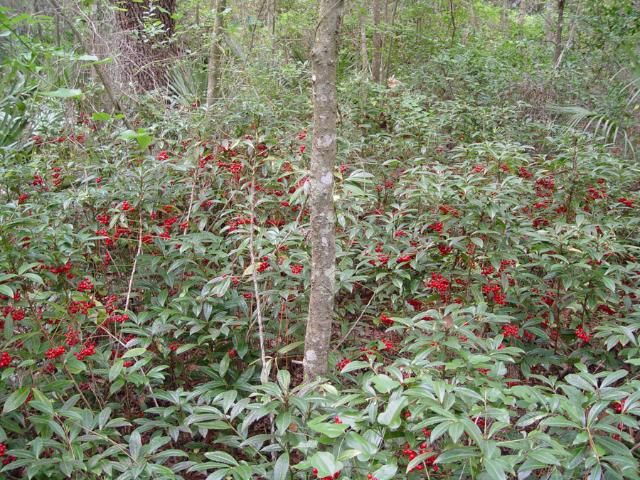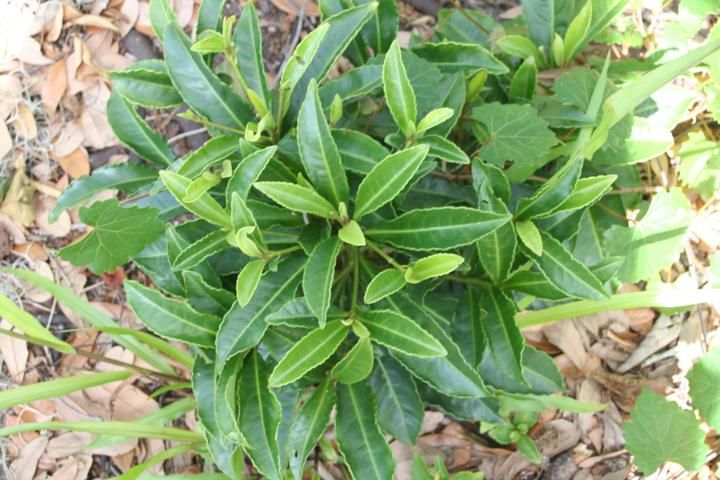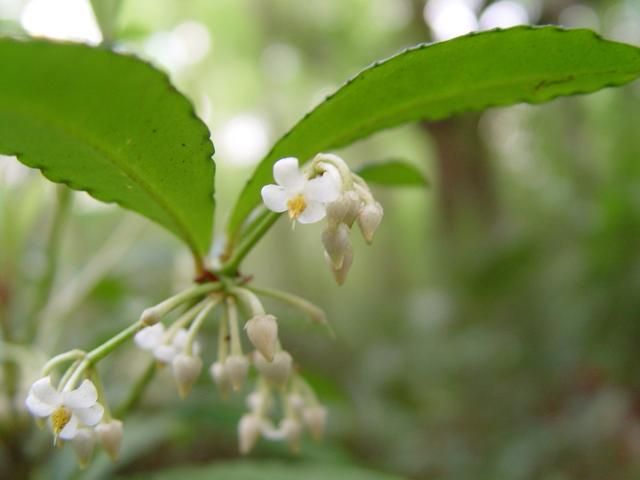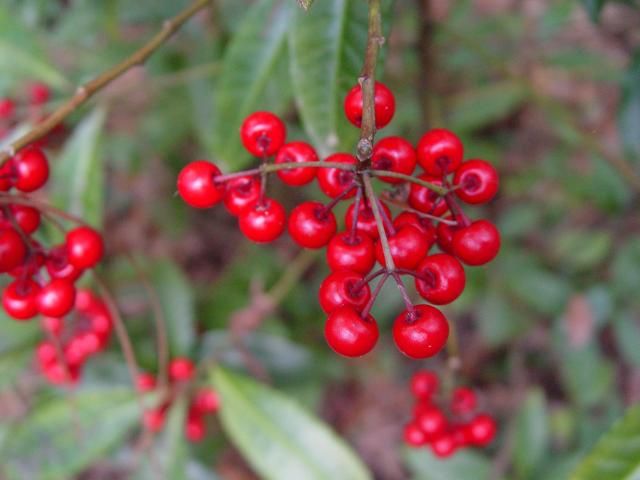Coral ardisia, also known as coral berry, spice berry, and scratchthroat, was introduced to Florida in the early 1900's for ornamental purposes (Figure 1). Since then, it has escaped cultivation, and it is found in hardwood hammocks and other moist, natural-wooded areas and grazing lands. Documented herbarium specimens, or preserved plants, have been collected from 43 counties in Florida (Wunderlin and Hansen 2024). Coral ardisia is considered invasive by the Florida Invasive Species Council (Category I) and the UF/IFAS Assessment of Non-native Plants (FISC 2019; UF/IFAS 2018); it was added to the Florida Noxious Weed List in 2014. This publication provides information for the identification and management of coral ardisia that is important to owners and managers of grazinglands and natural areas.

Credit: Michael Meisenburg
Identification
Coral ardisia is an evergreen, sub-shrub that reaches heights of 1.5 to 6 feet. It tends to grow in multi-stemmed clumps. The alternate, waxy leaves are about 8 inches long, and they are dark green above. They are also hairless, with scalloped margins and calluses in the margin notches (Figure 2). Flowers are typically pink to white in stalked axillary clusters, usually drooping below the foliage (Figure 3). The fruit is bright red, globular, and one-seeded, measuring about 0.25 inches in diameter (Figure 4). Berries tend to persist on the plant nearly year-round, and white-berried populations also exist.

Credit: Brent Sellers, UF/IFAS

Credit: Michael Meisenburg

Credit: Michael Meisenburg
Toxicity
Although there is no published literature supporting the toxicity of coral ardisia to livestock, it is suspected that the berries and/or foliage are poisonous to livestock, pets, and humans. In 2001, 2007, 2012, and 2020, the plant was the suspected causal agent for cattle deaths in Florida.
Control
Coral ardisia can be suppressed by using foliar applications of 2.25% v/v (volume to volume) solution of triclopyr ester-containing products (Garlon 4 Ultra, Remedy Ultra, others), 3% triclopyr amine-containing products (Garlon 3A, others), 3.14% v/v triclopyr acid (Trycera), 5% v/v imazamox (Clearcast, Castaway, others), or 1% imazapic-containing products (Impose, Panoramic, Plateau) (Table 1). Research by Hutchinson et al. (2011) indicated that high volume foliar applications of triclopyr, imazapic, or a combination of these two active ingredients provided >90% control of mature plants. However, research by Cristan et al. (2019) indicates that two applications of low-volume foliar applications (<50 gallons per acre of spray solution) will be necessary to obtain >90% control of mature plants. Basal bark applications with an 18% v/v solution of Garlon 4 or Remedy Ultra in an oil carrier can also control the plant. Complete coverage is essential when using foliar applications. Product restrictions differ according to the application site; reading the label prior to application is extremely important to ensure that the particular product is labeled for your application site as well as to prevent over application of any of these herbicides. Regardless of the application method, retreatment will be necessary for complete control as there will typically be a new flush of seedlings following most treatments. For more information on basal bark applications, visit https://edis.ifas.ufl.edu/AG245 to read the EDIS publication entitled Herbicide Application Techniques for Woody Plant Control.
References and Further Reading
2019 FISC List of Invasive Plant Species. Florida Invasive Species Council. (2019). Retrieved May 29, 2024, from https://floridainvasivespecies.org/plantlist2019.cfm.
Cristan, R., P. J. Minogue, S. F. Enloe, B. Sellers and A. Osiecka. 2019. Selective herbicides for control of hen’s eyes (Ardisia crenata) in forests and natural areas. Invasive Plant Sci. Manag. 12:229-235.
Hutchinson, J. T., K. A. Langeland, and M. Miesenberg. 2011. Field trials for herbicide control of coral ardisia (Ardisia crenata) in natural areas of north-central Florida. Invasive Plant Sci Manag. 4: 234–238.
University of Florida, Institute of Food and Agricultural Sciences. 2018. “Assessment of Non-native Plants in Florida’s Natural Areas, Ardisia crenata” (https://assessment.ifas.ufl.edu/assessments/ardisia-crenata/, Accessed May 29, 2024) Gainesville, FL, 32611-4000, USA.
Wunderlin, R. P., B. F. Hansen, A. R. Franck, and F. B. Essig. 2024. Atlas of Florida Plants (http://florida.plantatlas.usf.edu/). [S. M. Landry and K. N. Campbell (application development), USF Water Institute.] Institute for Systematic Botany, University of South Florida, Tampa.
Table 1. Control of mature and seedling coral ardisia with selected herbicides 12 months after a single foliar treatment (12 MAT1) or 12 months after sequential annual foliar treatments (12 MAT2). Adapted from Hutchinson et al. 2011 and Cristan et al. 2019.